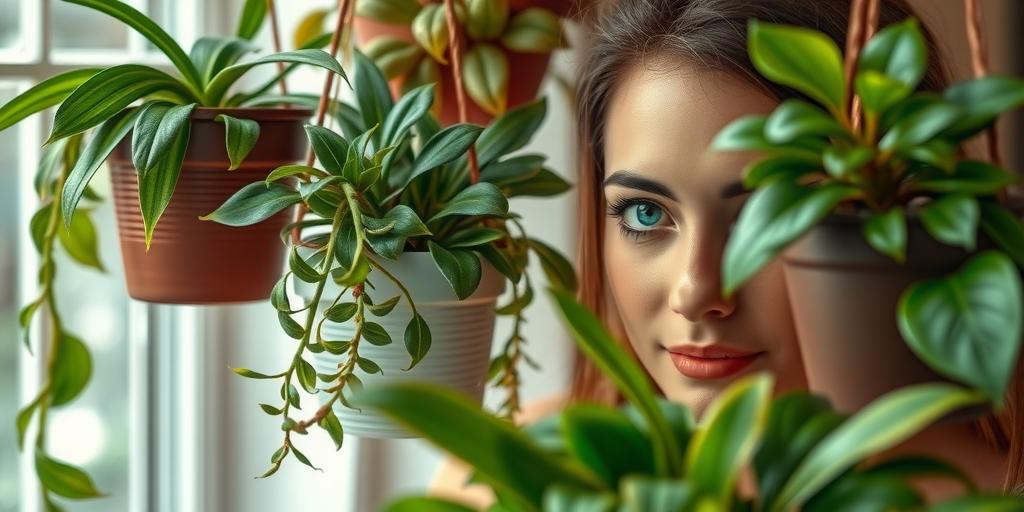
Best Hanging Plants That Thrive in Low Light and Humid Spaces
Discover the best hanging plants for low light and humid spaces! From lush ferns to air-purifying pothos, this guide covers easy-care plants perfect for bathrooms, kitchens, and dim corners.
Introduction
Did you know that some plants actually thrive in low light and high humidity? If you’ve ever struggled to keep greenery alive in dim, damp spaces like bathrooms or basements, you’re not alone. But here’s the good news—there are plenty of gorgeous hanging plants that love these conditions! In this guide, we’ll explore the top low-light, humidity-loving hanging plants that are not only easy to care for but also add a touch of nature to your home. Whether you’re a beginner or a seasoned plant parent, you’ll find the perfect green companion for those tricky spaces.
Why Choose Hanging Plants for Low Light and Humid Areas?
Hanging plants are a fantastic solution for small or dimly lit spaces where floor or table space is limited. They bring life and greenery to areas that might otherwise feel dull or cramped. Plus, many hanging plants naturally thrive in humid environments, making them perfect for bathrooms, kitchens, or even laundry rooms where moisture levels are higher.
Benefits of Hanging Plants in Small or Dim Spaces
If your home doesn’t get a lot of natural light, hanging plants can still flourish. Many low-light varieties adapt well to indirect or filtered sunlight, so they won’t wither away in darker corners. Additionally, suspending plants from the ceiling or walls keeps them out of the way while still adding visual interest.
How Humidity Helps Certain Plants Thrive
Some plants, like ferns and tropical species, naturally grow in humid environments. Bathrooms and kitchens mimic these conditions, providing the moisture these plants crave. The extra humidity helps keep their leaves lush and prevents them from drying out, reducing the need for frequent watering.
Space-Saving Advantages of Vertical Greenery
Hanging plants maximize vertical space, making them ideal for apartments or small homes. Instead of cluttering shelves or countertops, you can let vines cascade from a macramé hanger or mounted bracket, creating a living wall effect without sacrificing floor space.
Top Hanging Plants for Low Light and Humidity
Not all plants can handle low light and high humidity, but these seven varieties are perfect for the job.
1. Pothos (Epipremnum aureum)
Pothos is one of the most forgiving plants out there. It adapts well to low-light conditions and actually thrives in humid spaces like bathrooms. Its long, trailing vines look stunning in hanging baskets, spilling over the edges for a lush, cascading effect. Plus, it’s incredibly easy to propagate—just snip a vine and place it in water to grow a whole new plant.
2. Spider Plant (Chlorophytum comosum)
Spider plants are another low-maintenance favorite. They tolerate low light and love humidity, making them great for steamy bathrooms. One of their coolest features is the “spiderettes” they produce—little baby plants that dangle from the mother plant. These can be snipped off and potted to expand your collection. Spider plants are also known for their air-purifying qualities, helping to keep indoor air fresh.
3. Boston Fern (Nephrolepis exaltata)
If you want a plant that screams “jungle vibes,” the Boston fern is it. This plant loves moisture and indirect light, so it’s perfect for bathrooms or kitchens. Its feathery, arching fronds add a soft, textured look to any space. Just be sure to keep the soil consistently moist—these ferns don’t like to dry out.
4. Philodendron Heartleaf (Philodendron hederaceum)
The heartleaf philodendron is a fast grower with charming, heart-shaped leaves. It thrives in low light and humid conditions, making it a great choice for hanging in a bathroom or near a kitchen window. Its vines can grow several feet long, creating a beautiful, tropical cascade.
5. Staghorn Fern (Platycerium bifurcatum)
Staghorn ferns are unique with their antler-like fronds. They prefer humidity and indirect light, and they can be displayed in creative ways—either mounted on a wooden board or hung in a basket. These ferns absorb moisture through their fronds, so misting them occasionally helps keep them happy.
6. Maidenhair Fern (Adiantum spp.)
For a touch of elegance, the maidenhair fern is a stunning choice. Its delicate, lacy foliage looks almost ethereal, but it does require consistent moisture and low light to thrive. Bathrooms with diffused light are ideal for this plant, as the humidity helps prevent its fragile leaves from crisping up.
7. Peperomia (Peperomia spp.)
Peperomias come in a variety of shapes, colors, and textures, making them a versatile pick for hanging planters. They enjoy humidity and indirect light, and their compact size means they won’t take over your space. Some varieties, like the watermelon peperomia, have striking leaf patterns that add visual interest.
Care Tips for Low-Light Hanging Plants
Keeping your hanging plants healthy in low-light, humid conditions requires a few key care strategies.
Watering Guidelines to Prevent Root Rot
Overwatering is a common issue, especially in humid spaces where soil takes longer to dry. Always check the soil before watering—stick your finger in about an inch deep. If it’s dry, it’s time to water; if it’s still moist, wait a few more days. Well-draining pots with drainage holes help prevent soggy roots.
Best Soil Mixes for Moisture Retention
A lightweight, well-aerated potting mix works best for most hanging plants. Adding perlite or orchid bark improves drainage, while a bit of peat moss or coco coir helps retain moisture without waterlogging the roots.
How to Increase Humidity Naturally
If your space isn’t naturally humid, try grouping plants together—they release moisture through transpiration, creating a mini-humid microclimate. You can also place a tray of water near your plants or use a small humidifier.
Signs Your Plant Needs More (or Less) Light
Yellowing leaves or leggy growth often means your plant isn’t getting enough light. If leaves are scorched or fading, it might be getting too much direct sun. Adjust placement accordingly—moving a plant just a few feet can make a big difference.
Styling Ideas for Hanging Plants in Humid Spaces
Once you’ve picked your plants, it’s time to get creative with how you display them.
Best Spots to Hang Plants in Bathrooms and Kitchens
In bathrooms, hang plants near a frosted window or above a bathtub where they’ll benefit from steam. In kitchens, consider placing them near a sink or window where they’ll get indirect light and occasional humidity from cooking.
Creative Ways to Display Trailing Plants
Macramé hangers add a boho touch, while wall-mounted shelves with hooks let you arrange multiple plants at different heights. For a modern look, try geometric planters or glass terrariums.
Pairing Plants for a Lush, Layered Look
Combine different textures and lengths for visual depth—pair a trailing pothos with a fuller fern, or mix a spider plant’s arching leaves with the delicate fronds of a maidenhair fern. The contrast creates a dynamic, jungle-like effect.
By choosing the right plants and giving them the care they need, you can transform even the darkest, most humid corners of your home into thriving green oases.
Conclusion
Transforming dim, humid spaces into green oases is easier than you think! With the right hanging plants—like pothos, ferns, and philodendrons—you can enjoy lush, thriving greenery even in low-light conditions. Ready to elevate your space? Pick a plant (or three!) from this list and watch them flourish. Don’t forget to share your favorite low-light hanging plants in the comments!
